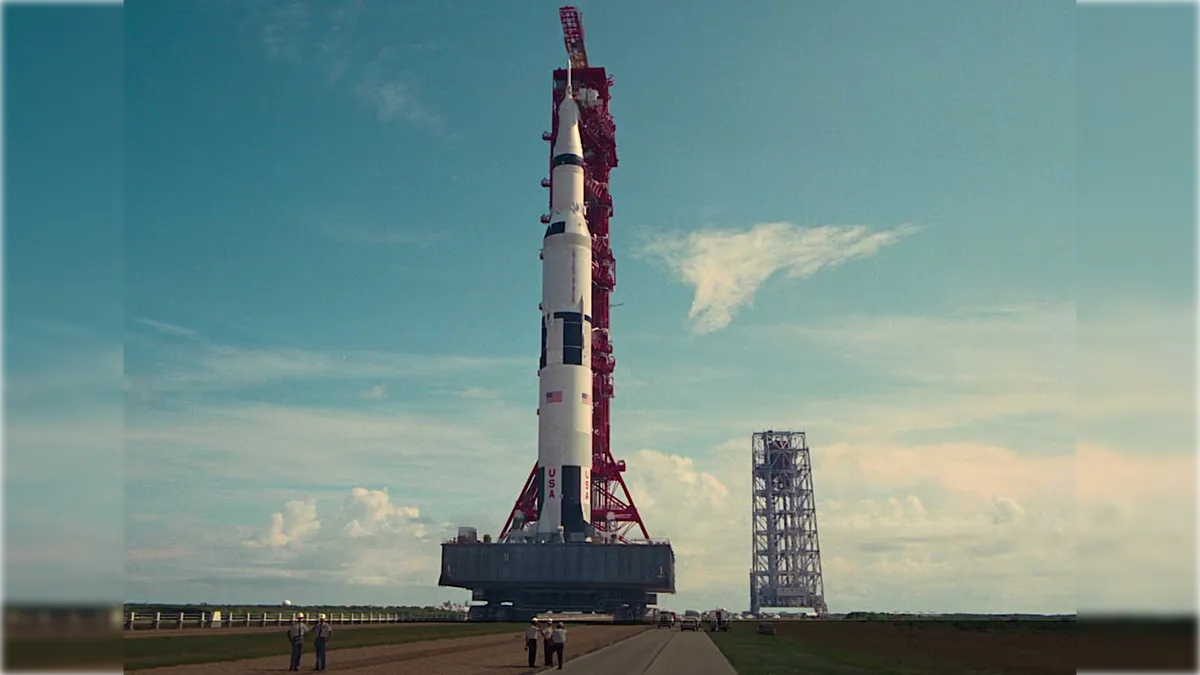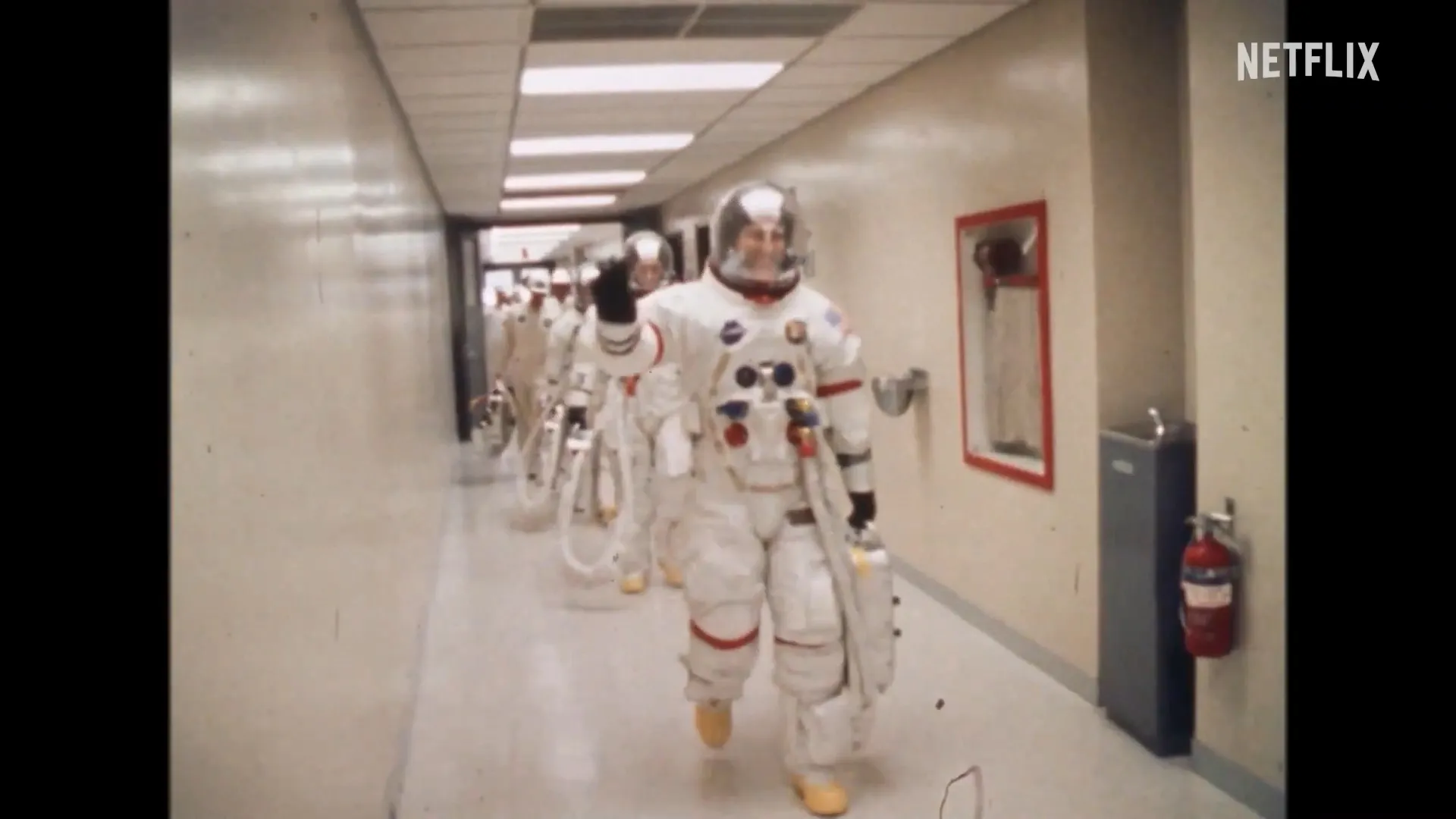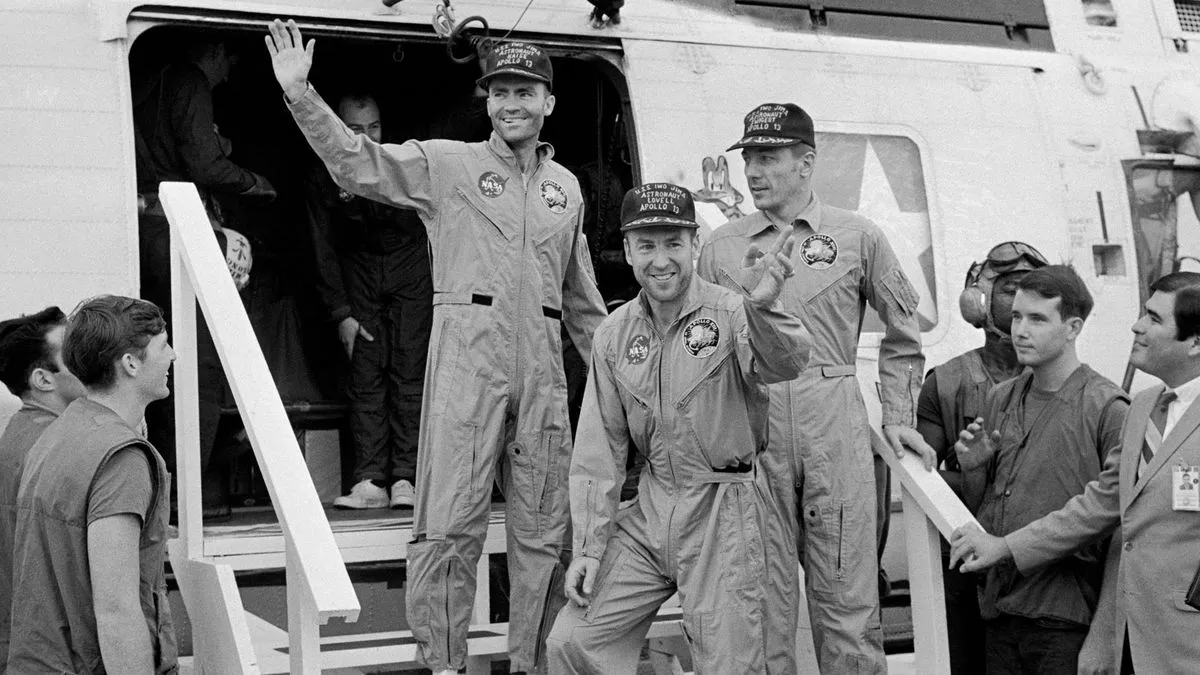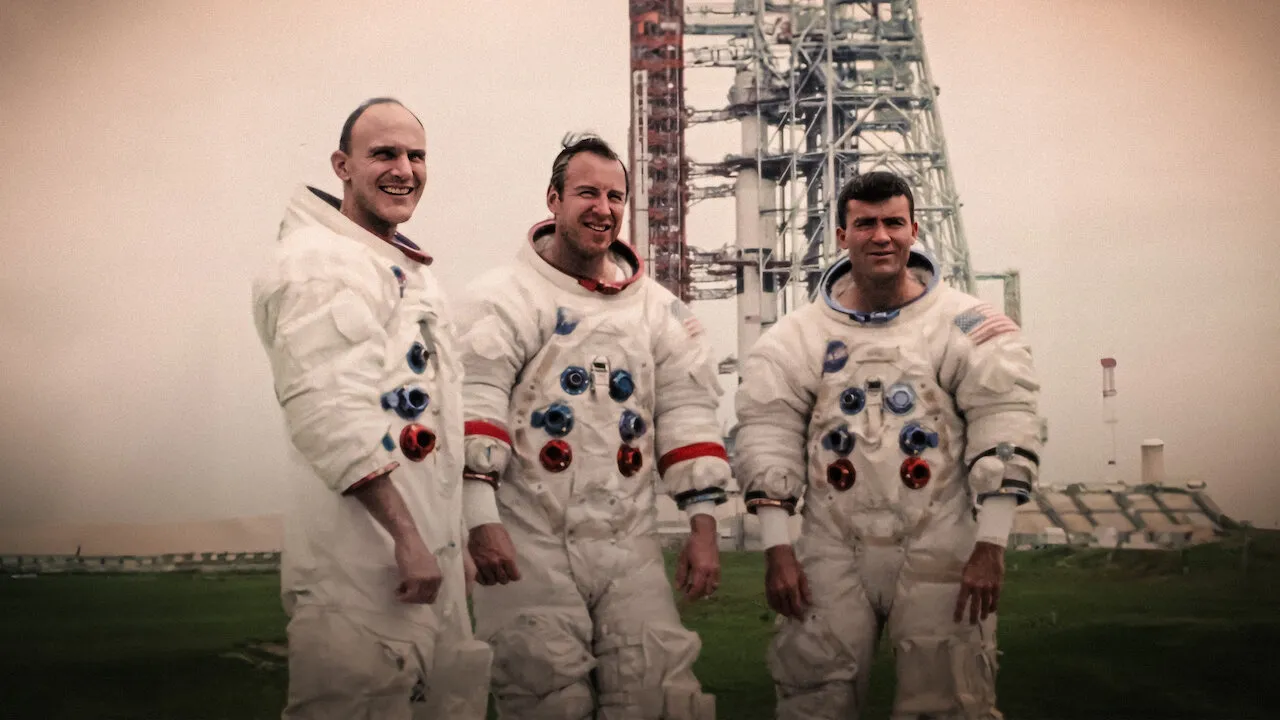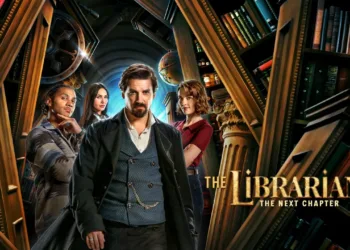As the film begins, we’re immediately plunged into the unfolding events of that famous, flawed mission to the moon. Through restored recordings and footage, we experience the mission as if we were there. Every moment is brought to life with such clarity and intimacy.
We join the astronauts aboard Apollo 13 in the early hours, all going to plan as their craft lifts off from the launchpad. But just over two days into the journey, with the crew encamped over 200,000 miles into the black, distant void, it all changes in an instant. An explosion—the cause still unknown all these years later. Oxygen venting, electrical systems crashing, a wave of panic and uncertainty washing over the crew, and everyone following back on earth.
Director Peter Middleton understands that sometimes the most compelling storytelling comes from simply stepping aside and letting the historical record speak for itself. Through meticulously sourced archives, we share those first terrifying moments with Fred, Jack, and Jim as the full gravity of the situation becomes clear.
And across the following four days, confined to the lunar module in worsening conditions, we experience alongside them every spike of tension and adrenaline as innovation and calculation become their only hope.
It’s a masterful retelling, immersing us fully in the minute-to-minute battle for survival. Middleton trusts that the authenticity and rawness of the archival material will keep us on the edge of our seats, even though the ultimate outcome is already known. And it’s a testament to both the filmmaking and the tremendous human drama of those events that, more than half a century later, he’s absolutely right.
Living Every Moment
This film doesn’t just recount the events of Apollo 13, it places you right in the middle of the action. Through restored audio recordings and found footage, we join the crew onboard their spacecraft in real-time. Every development, from the initial moments of celebration at liftoff to the dawning horror of the explosion, happens as if we’re experiencing it alongside them.
Then we shift to Mission Control in Houston. Cameras capture the tense discussions and split-second decisions in the windowless room. Combined with the crew’s transmissions beaming back to earth, the archive pulls no punches in conveying the immense pressures at play. At the same time, home movies give a window into the family drama playing out from the Lovell household. Marilyn’s fear and round-the-clock vigil say as much as any words.
Some truly astounding footage comes from the lunar module itself. Hidden camera rolls of critical engine burns put us in the cockpit through the most perilous procedures. Elsewhere, a scruffy filter crafted in the vacuum of space shows just how far innovation was stretched. Throughout, interviews provide valuable context but never disrupt the fly-on-the-wall sensation of reliving those four days in real-time.
The director understands that letting the archive speak for itself is the purest route to relaying these high-stakes events. Nothing is missed—every fine detail contributes to setting the scene and conveying the stakes. By curating what’s been recovered into a seamless minute-by-minute retelling, the film honors history while keeping us on the edge of our seats.
Immersive Archive Approach
This film knows that letting history speak for itself is the purest way to share this story. No talking heads or reenactments get in the way; it’s just detail after heart-pounding detail from the archives. You truly feel like you’re living those tense moments alongside the crew and mission control.
Every audio recording and uncovered scrap of film brings the magnitude of the crisis into clearer focus. But it’s handled without sensationalism—no need to amp up the drama when real events are this gripping. The director seems to understand viewers are smart enough to fill in the gaps and grasp the stakes.
It reminds me of how documentaries about Apollo 11 absorb you in their restoration of footage from the first lunar landing. There’s no replacing being there through the eyes of those who experienced it. This trust in authentically presenting history as it unfolded keeps you on edge throughout.
It’s refreshing to learn about this pivotal event without unnecessary explanation or recap. Plunging right back in time transports you straight to mission control alongside the astronauts, sharing their peril in real-time. No other approach could better convey just how remarkably those moments unfolded and the immense challenge overcome. Some stories are too important not to experience as close to first-hand as technology allows.
A Moment of Relief
It’s easy to get wrapped up in the technical details of the mission, but this film ensures we don’t lose sight of the very real human impact. Throughout, the crew’s ice-cold professionalism is palpable. But in chosen archive moments, we see past the facade—like camera shots capturing the barely contained panic on Marilyn Lovell’s face.
In cruising photos released to the press, her growing anxiety is plain to see. We understand the agony of waiting with no idea what’s unfolding in the black beyond. Her worry puts flecks of humanity into the clinical mission play-by-plays. In contrasting these perspectives, the director highlights how personal the stakes were.
That visceral release upon the capsule entering radio contact is impossible to forget. Sharing that collective sigh of relief with crowds and loved ones gathered brings the experience proudly into the present. We feel the fear, sorrow, and joy intertwined with progress and discovery.
No dry details alone could convey the sacrifice of putting family pursuits aside to take part in humankind’s frontier pushes. In scanning reactions both within mission control and from the home front, the film acknowledges those who ensured a safe return was possible. Technical achievements don’t diminish the emotional cost of space exploration, as this film so artfully shows.
Striking the Right Balance
At just over an hour and a half, you can’t help but want more of this riveting story. But fitting everything into such a timeframe was never going to be easy. A few extra details here and there could have rounded things out.
More context on where this mission stood within Apollo’s broader timeline might have shown what was really at stake. And depicting how a transfixed public experienced this drama as it unfolded in real-time adds another layer.
A few more minutes spent on that white-knuckle plunge back into Earth’s atmosphere would have satisfied any lingering cliffhangers. But quality always matters more than quantity.
Rather than rush through or speculate post-mission, the director honors historical authenticity. Staying wedded to the archives means we live those four nail-biting days as they happened. And not a moment is wasted.
Documenting an event so momentous within reasonable limits was never going to be simple. In prioritizing accuracy over superfluous extras, this film hits the right balance. Some stories deserve telling as truthfully as technology allows, even when brevity must be the cost.
A Story for the Ages
While some events do briefly bring the world together, it’s debatable if Apollo 13 alone truly did so. But there’s no question the mission inspired countless others in its darkest hours.
Against implausible odds and through perseverance alone, Mission Control helped snatch victory from the jaws of defeat. Their relentless dedication and split-second thinking under pressure remind us what human ingenuity is capable of.
Even half a century later, the footage of celebration at crew recovery retains its raw emotional impact. We witness joy at the life-affirming power of exploration and relief that our species’ drive to push boundaries can triumph over even the longest odds.
With a masterful weave of private and public perspectives, the film does right by the rich historical tapestry. It grasps what made this doomed flight to the moon so unforgettable—the fragile beauty of hope interred even in our most perilous moments.
Some stories keep their ability to unite generations because certain virtues transcend time. Apollo 13 proves the continuing ability of the human spirit to create light where once there was darkness. For that alone, its legacy as inspiration is assured.
Conclusion
This film shows how history comes alive when the right archives find the spotlight. By trusting restored recordings and footage to shine without interference, we’re pulled straight back to those pulse-pounding days.
No talking heads or explanations could substitute living side-by-side with the crew through sheer authentic material. The director understands that some tales are too epic not to experience as close to originally as technology allows.
By curating a lost world of audiovisual history, we glimpse afresh how resilience and courage prevailed against what seemed insurmountable odds. And the human lives that underpinned scientific breakthroughs come into focus alongside technical theatrics.
All these decades later, this doomed mission to the Moon still inspires through ordinary people accomplishing extraordinary feats. Their story and the ingenuity of the wider community who ensured three astronauts’ return deserve remembering as faithfully as archives permit. In that regard, this film triumphantly.
Some parts of our shared human experience withstand the test of time because certain virtues will never fade. Through its restoration of history, this film honors both technical wonder and the spirit that triumphed even in crisis. For that, Apollo 13’s legacy as inspiration is sure to endure.
The Review
Apollo 13: Survival
Through meticulous restoration and assembly of archival sources, this film breathes new life into familiar events. We experience the famous mission as never before, immersed directly in historic audio recordings and glimpses behind the scenes.
PROS
- Authentic use of restored archival audio and footage transports viewers directly to the events.
- Gripping minute-by-minute recreation of the mission keeps viewers on the edge of their seats.
- Provides both technical and personal perspectives, highlighting human stories behind achievements.
- Abstains from unnecessary embellishments, letting raw history speak for itself.
- Positively compares to other films relying heavily on archival sources like Apollo 11.
CONS
- Very minor criticism that additional context/footage could have enhanced understanding
- A short runtime of 96 minutes leaves some wanting more details.









































